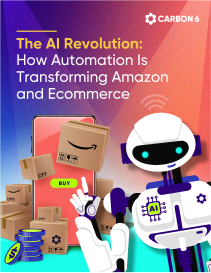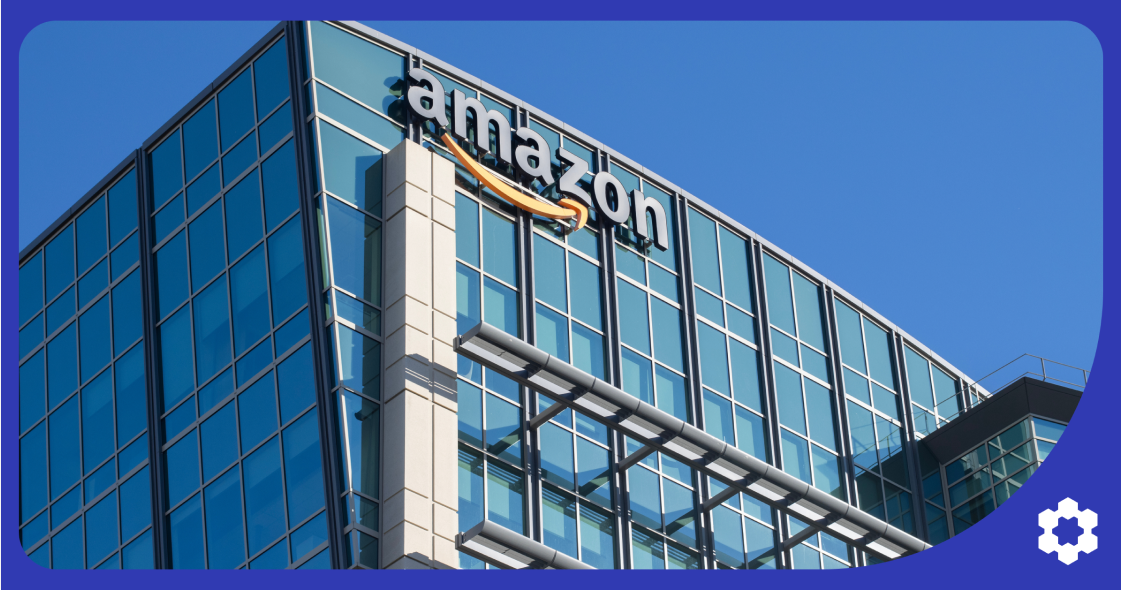Top Seller News This Week
This week’s Amazon seller updates come amid a flurry of mixed signals from the company’s latest earnings report.
- Amazon posts strong Q2 results but offers a cautious outlook: Amazon exceeded analyst expectations in its second quarter, reporting revenue of $167.7B (a 13% increase from the same period last year) and net profit of $18.2B (a 35% increase from $13.5 billion in Q2 2024). However, its Q3 2025 operating income (profit before taxes) forecast of $15.5–$20.5 billion disappointed investors expecting quicker returns from AI investments, given minimal growth from Q3 2024’s $17.4 billion.
- Amazon Web Services (AWS) revenue climbs, but growth lags behind key rivals: AWS brought in $30.9 billion in Q2 revenue and $10.2 billion in operating income. However, AWS grew just 17.5% year over year (YoY), well behind Microsoft Azure (39%) and Google Cloud (32%). Analysts noted that AWS’s performance, while solid, was underwhelming compared to the momentum seen from competitors.
- Mixed earnings reaction impacts Jeff Bezos’s net worth: Following the Amazon Q2 earnings 2025 release, its shares dropped over 8%, shaving $17B off Jeff Bezos’ net worth in a single day. Although the company beat Wall Street expectations on profit and revenue, AWS’s slower-than-expected growth drove the negative market response.
Read on as we break down what these Amazon updates mean for sellers, including insights into how the company’s changing priorities around AI, cloud infrastructure, and cost management may ripple across its platform, partners, and services.
Amazon Q2 Earnings 2025: Strong Earnings, Slowing Cloud, and What It Means for Sellers
Amazon’s Q2 2025 earnings report delivered a mixed message: strong topline growth and profitability, but rising concerns about cloud momentum.
The company posted $168.2 billion in revenue, up 13% year over year, and net income of $10.7 billion, beating analyst expectations across the board. Retail, advertising, and seller services all delivered double-digit gains, helping Amazon maintain its dominance across multiple business lines.
But despite the beat, Amazon’s stock fell more than 8% after the report, largely due to cautious Q3 2025 outlook and lingering questions about AWS, the company’s most profitable business segment.
Amazon Web Services vs Google Cloud vs Azure
Amazon announced solid second-quarter results for its cloud division: $30.9 billion in revenue, up 17.5% YoY. However, that wasn’t enough to impress Wall Street. Microsoft Azure and Google Cloud grew much faster at 39% and 32%, respectively. Despite AWS holding the top market share at 30%, its slower growth revived concerns about whether Amazon is falling behind in the AI infrastructure arms race.
Q2 2025 Cloud Performance Comparison
| Metric | AWS | Microsoft | |
| Revenue | $30.9B | $29.9B | $13.6B |
| Annual Run Rate per CRN (projected yearly revenue) | $124B | $120B | $54B |
| YoY Revenue Growth | 17.5% | 26% (Intelligent Cloud, Microsoft’s broader data platform), 39% (Azure) | 32% |
| Operating Income (profit before taxes) | $10.2B | $12.1B | $2.8B |
| Global Market Share (per Synergy Research Group) | 30% | 20% | 13% |
Based on the data above, AWS remains the market leader with 30% global share. However, its slower 17.5% YoY growth suggests market maturity and possible saturation. Yet, AWS continues to deliver strong profitability with $10.2 billion in operating income. Amazon’s total revenue reached $168B, with AWS contributing more than half of the company’s total operating income for Q2 ($10.2B of $19.2B).
Microsoft Azure, through its Intelligent Cloud segment, generated $29.9 billion in revenue (just behind Amazon’s $30.9B from AWS). Azure-specific services grew 39% YoY, showcasing rapid progress across AI workloads. Additionally, Microsoft leads in operating income at $12.1B, and its total company operating income hit $34 billion, reflecting the strategic advantage of its tightly integrated AI and cloud stack.
Meanwhile, Google Cloud posted the fastest growth at 32% YoY, reaching a $54B annual run rate. It delivered $2.8 billion in operating income, up 133% year over year, marking a major improvement from past losses. Google’s AI-first approach, including investments in tools like Gemini and Vertex AI, is clearly gaining traction.

Unlock the future of ecommerce with our AI Revolution white paper. Discover how leading Amazon sellers leverage AI for personalization, product research, and advertising optimization. Download your free guide now and start integrating AI.
Analysts Weigh In on AWS’s Mixed Signals
Jefferies analyst Brent Thill called AWS’s growth disappointing in the context of competitor acceleration, while William Blair analysts Dylan Carden and Arjun Bhatia noted the modest pace of AWS’s uptick compared to the significant gains at Azure and Google Cloud.
Wedbush’s Scott Devitt warned AWS’s image as an AI leader may be taking a hit, even if its long-term potential remains intact.
That sentiment played out in the markets. Amazon’s stock dropped 8.3% following the earnings announcement, erasing $17 billion from Jeff Bezos’s net worth in a single day. The decline was largely attributed to concerns about AWS’s lagging growth rate, even as the company delivered strong bottom-line results.
Still, many analysts are not abandoning ship. RBC Capital Markets’s Brad Erickson called the quarter “an uncharacteristic setback,” but expects AWS to gather steam in the back half of 2025 as new data centers and AI capabilities come online. And while AWS may be trailing its rivals in growth rate, it still leads the cloud market in both revenue and operating income.
Amazon’s Response: It’s Still Early
CEO Andy Jassy defended the less-than-stellar AWS Q2 revenue, saying much of today’s generative AI activity is still in the training and testing phase. He believes customers will eventually choose AWS due to its data proximity and cost advantages.
Capacity, Not Demand, Is the Problem
Jassy and others pointed out that AWS demand isn’t the issue; it’s infrastructure. Amazon spent $31.4 billion on capital expenditures in Q2, aiming to scale its data centers to keep pace. In a statement to Benzinga, tech expert Eric Allen called the market’s reaction to the earnings “totally wrong,” attributing AWS’s slower growth to infrastructure bottlenecks rather than lack of interest.
Key Takeaway for Sellers
While AWS may be growing more slowly, Amazon’s continued dominance in cloud market share means the core tools and services you depend on aren’t going anywhere. But longer wait times for new AI-driven features and services may persist as AWS plays catch-up.
Retail, Advertising, and Seller Services Remain Bright Spots
Although AWS underwhelmed some investors, Amazon’s retail ecosystem delivered strong results, particularly in seller services and advertising, which are crucial areas for third-party sellers and vendors.
- Retail sales growth holds steady: Amazon’s online stores grew 11% YoY to $61.5 billion, while seller services hit $40.3 billion, also up 11%, both exceeding analyst expectations. Jassy noted that tariffs and trade uncertainties had not yet significantly impacted pricing or demand, offering some reassurance for sellers importing goods from China.
- Advertising surges again: Amazon’s ad business grew 23% to $15.7 billion, outpacing both Google and Meta’s advertising growth during the same period. With more shoppers turning to Amazon’s search engine over Google for product discovery, ad investment continues to offer strong ROI for brands.
- Delivery improvements drive conversion: Amazon’s logistics improvements have led to faster and cheaper delivery, which can directly benefit sellers by increasing customer satisfaction and repeat purchases.
What does this mean? Advertising and fulfillment enhancements remain Amazon’s key areas of competitive strength. This is good news for brands investing in Amazon Ads and those leveraging FBA to win the Buy Box.
Expand your reach with DSP Prime. Our expert-managed advertising solution leverages Amazon’s first-party data to connect your brand with high-intent audiences across websites, apps, and streaming platforms. Get your customized growth plan now and launch in just 10 days.
Other Seller Updates This Week
1. New Display Ads for Alexa+ Devices Streamline Campaign Creation
Amazon has introduced Component Based Creatives for display ads on Alexa+ Echo Show devices in the US, UK, and Germany. These next-gen ads dynamically adjust to different screen sizes and reduce campaign setup time by half, while supporting video playback or click-through to external sites, all without the need for custom creative assets.
2. Amazon Introduces “Star-Only” Seller Feedback, And Sellers Aren’t Happy
Starting August 4, customers can leave feedback using just star ratings, without writing a review. While Amazon claims this simplifies the process and may lead to more (and more positive) ratings, many sellers are concerned about the lack of context for appeals and the potential for abuse or misattributed reviews.
3. Faster Delivery with New Premium Shipping Options
Eligible sellers can now offer 1- and 2-day regional deliveries through the Premium Shipping program. With added protections for on-time delivery rate (OTDR) metrics when using OTDR-protected shipping labels, this update allows sellers to boost delivery speed without risking their performance score, provided they maintain high fulfillment standards.
4. Boost Sales with Flexible, Interest-Free Installment Payments (UK)
Through Amazon UK’s new Flexible Customer Financing program, sellers can offer buyers interest-free installment payments on eligible products. This feature can drive up to 30% higher sales on big-ticket items, and sellers still receive full payment upfront, along with detailed performance reporting in Seller Central.
5. Myntra, Owned by Walmart, Launches Glamstream in India
Glamstream combines entertainment and ecommerce with 500+ hours of celebrity- and creator-led content, including music, travel, weddings, and beauty shows. This marks a monumental step into social commerce for the Indian market and highlights how global ecommerce is blending content with shopping.
6. Tap into Central & Eastern Europe Ecommerce for 15% Annual Growth
Recent data from the Balkan Ecommerce Summit reveals that Central and Eastern Europe as a prime expansion opportunity for US Amazon sellers, with €124 billion projected market value in 2024. Check out our insights on how to tap into this fast-growing region where 57% of consumers already shop cross-border.
Finding Advantage in Amazon’s Q2 Slowdown
Amazon’s Q2 2025 results were strong overall, but AWS growth may be slower than anticipated. For sellers, this means: Amazon’s marketplace is still solid and expanding while AI infrastructure hinders innovation. Here’s how to prepare:
- Double down on Amazon Ads: With ad revenue up 23% and ROI staying strong, now is the time to optimize your ad spend. Lean into different ad types and test new formats like AI-generated contextual pause ads and shoppable ads for Prime Video.
- Invest in FBA and fast shipping: Amazon’s fulfillment upgrades are paying off. Use FBA or SFP with fast delivery settings to drive sales (customers are likely to reorder due to speedy delivery) and boost customer satisfaction.
- Increase inventory coverage for fast-moving ASINs: With sales growing across retail and seller services, make sure your bestsellers are always in stock, especially those tied to seasonal or promotional events.
- Stay patient on AI tools: Delays in AWS rollout may slow the launch of new AI features. Consider exploring third-party tools for customer support and demand forecasting in the meantime.
For nearly four years, we’ve kept sellers informed with our Amazon Sellers Newsletter, publishing over 200 issues packed with policy changes, announcements, and community events. Subscribe or share with your team to get these insights delivered weekly.








